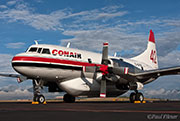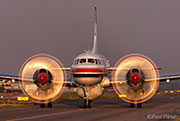In June, Colorado saw two hugely destructive fires in quick succession, and, while he was not in the country for the whole time these fires burned, I was able to capture some interesting movements at Jeffco Tanker Base.
On 9th June the High Park Fire started to the west of Fort Collins, Colorado. Later it was ascertained that this had been started by a lightning strike.
The US fleet of tankers had been recently cut down to nine after the loss or two aircraft, with the fatal crash of Tanker 11 and the wheels-up landing of Tanker 55, both P2V-7 Neptunes.
Two Convair 580s operated by Conair of Canada had been sent down to Grand Junction in Colorado on standby the day before and were flown to Jeffco Tanker Base at Rocky Mountain Metro Airport on the 9th June, along with Bird-dog 134, a Rockwell Commander 680A. In Canada the tankers operate as a pair with their own Bird-dog and generally all travel around together.
CV-580 C-GYXC (Tanker 442) and C-FEKF (Tanker 445) only carry the last two digits of their callsigns on the tail, and, to stop confusion with the tanker numbers already used by the US Forest Service (USFS), they were renamed Tanker 142 and Tanker 145 respectively.
For C-FEKF, this was something of a homecoming back to the Denver Metro area, as this aircraft used to fly with Frontier Airlines between 1965 and 1974, which operated her as both a CV-340 and a CV-580 after its turboprop conversion. Rocky Mountain Airways also operated her locally in 1988.
The Canadian Bird-dog and US Lead planes fly differently, so thorough briefings were carried out ahead of the first flights of the day, and the following day more briefings were undertaken to iron out any questions or concerns. As expected with two bunches of professional aviators, no issues were reported once the Canadian crews understood how the USFS operates.
The same day a P2V-5 from Neptune Aviation (Tanker 44), a P2V-7 from Minden Corporation (Tanker 48), and a pair of Single Engine Air Tankers (SEAT) joined the fight.
The following day a third SEAT joined us at Jeffco Tanker Base with others flying from nearby Fort Collins. By this time many helicopters were also on the scene.
Starting on the 17th June loads were being diverted south to the Springer Fire as needs arose, and it was on one of these southerly missions that we got a glimpse of a drop as it looks from the front of the aircraft.
The video shows take-off, following the lead plane and extending a retardent line, and the subsequent landing. Tanker 45 used to have a landing light fitted in the nose, but this was taken out many years ago, and the captain decided it might be interesting to put my GoPro inside to record the action. The glass was more distorted than we suspected, but you get a good idea of the profile flown.
CV-580 Tanker 145 over the Springer Fire, Colorado
The High Park Fire was eventually 100% contained on 30th June with 87,250 acres burned and 259 homes destroyed. This was the second most destructive fire in Colorado history after the 2002 Hayman Fire, and at the time was the most destructive with regards to homes lost, surpassing the 2010 Fourmile Fire.
One week later, however, the destructive Waldo Canyon Fire, close to Colorado Springs, took this statistic higher with 346 homes destroyed. I was in Russia when this fire broke out, and so I missed the USAF MAFFS C-130s and a pair of Saskatchewan Convairs operating out of the Jeffco Tanker Base.
The High Park Fire gave me a unique opportunity to see the CV-580s in action south of their native Canada.
Subscribe to receive updates via: e-mail list | Facebook | Instragram | Twitter
[photo/serial list]
[photos from behind the scenes]

